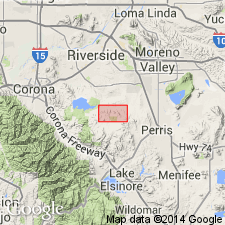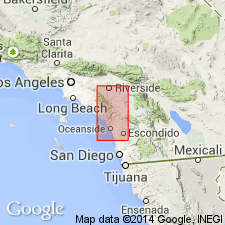
- Usage in publication:
-
- Val Verde tonalite
- Modifications:
-
- Named
- Dominant lithology:
-
- Tonalite
- Quartz diorite
- AAPG geologic province:
-
- Peninsular Ranges province
Summary:
Named credited to F.L. Ransome (1932, unpub. rept.). [Wilson (1937) credits author for description of Val Verde tonalite]. Crops out over entire eastern and central parts of Val Verde district, Riverside Co, CA and occurs in western part as isolated masses. Believed to underlie area of 150 sq mi on Perris Block. Is same as Perris quartz diorite of Dudley (1935). Tonalite is light-gray, medium-grained with gneissoid structure. Includes discoidal masses of dark, fine-grained rock ranging from less than an inch up to several tens of ft, arranged parallel to foliation. Intrudes schist [Triassic metamorphic series] but contacts are gradational and irregular suggesting assimilation. Age is probably Jurassic(?) based on correlation with similar rocks in Santa Ana Mountains.
Source: GNU records (USGS DDS-6; Menlo GNULEX).

- Usage in publication:
-
- Val Verde tonalite
- Modifications:
-
- Not used
- AAPG geologic province:
-
- Peninsular Ranges province
Summary:
Val Verde tonalite of Osborn (1939) is replaced by Bonsall tonalite of Hurlbut (1935). Age of Bonsall given as Cretaceous.
Source: GNU records (USGS DDS-6; Menlo GNULEX).
For more information, please contact Nancy Stamm, Geologic Names Committee Secretary.
Asterisk (*) indicates published by U.S. Geological Survey authors.
"No current usage" (†) implies that a name has been abandoned or has fallen into disuse. Former usage and, if known, replacement name given in parentheses ( ).
Slash (/) indicates name conflicts with nomenclatural guidelines (CSN, 1933; ACSN, 1961, 1970; NACSN, 1983, 2005, 2021). May be explained within brackets ([ ]).

